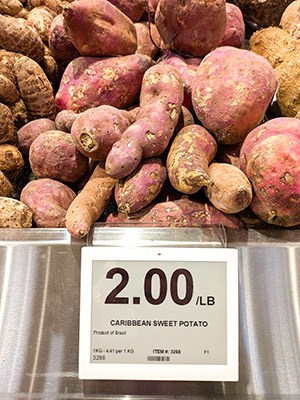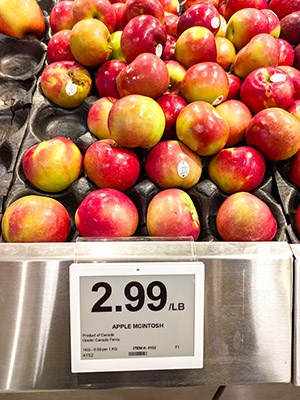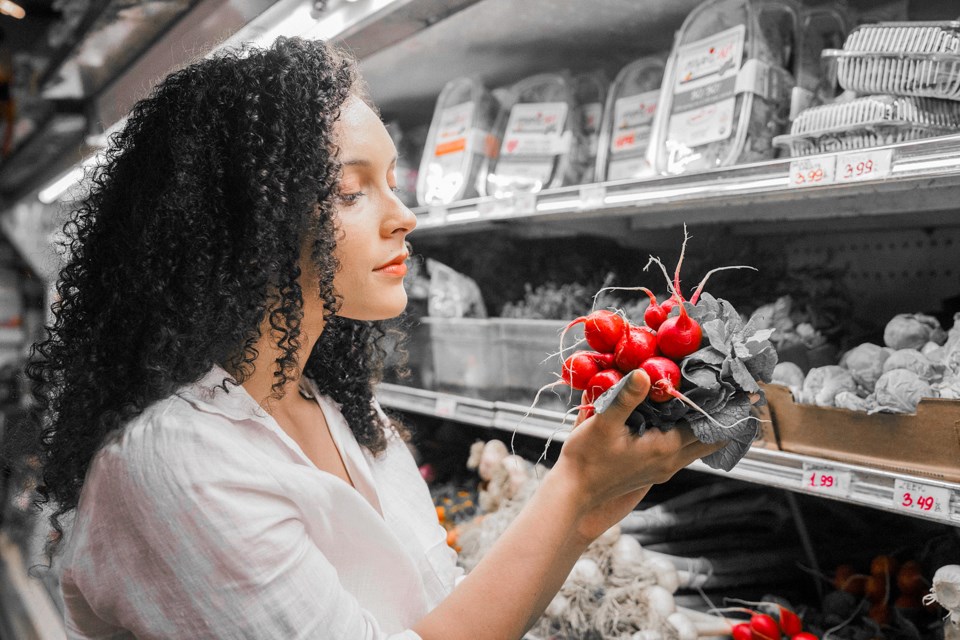This piece is based on publicly available information and personal visits this week to local food retailers. My goal is to show that we can shop easily and quickly for non-American based produce, thus supporting our own Canadian producers and growers, and those with whom we have dependable trade relations without loss of nutritional value or health risk.
Remember, we didn’t ask for this fight. I’ll admit that although supporting our own growers and producers is most important now and in the future, I don’t believe I’m alone in feeling a twinge of anything-but-American sentiment just now.
The tariffs have been paused, but this is Tuesday and who knows what tomorrow or Friday will bring. So bookmark this column for reference—or, perhaps better yet, consider a permanent switch away from U.S. products when possible.
Canadian Dietary Reference Intakes (DRIs) and Required Daily Allowances (RDAs) of nutrients have been used as a guide, and the information below is for consideration and discussion only. All retailers have stressed that produce on the shelves today, and its sourcing, is extremely fluid during our winter.
Understanding Canadian packaging terminology is critical to purposeful pro-Canadian shopping. Some companies and retailers use different or minimal labeling to fly under our Canadian Food Inspection Agency (CFIA) regulations. Understanding labels, or the significance of their ambiguity, is one of the quickest ways to decide which items to put back on the shelf rather than into your grocery cart.
Product of Canada labeling is defined as follows by CFIA: “A food product may use the claim "Product of Canada" when all or virtually all major ingredients, processing, and labour used to make the food product are Canadian. This means that all the significant ingredients in a food product are Canadian in origin and that non-Canadian material is negligible (less than two percent).” Non-Canadian material generally includes spices and vitamin and mineral supplements. For my shopping purposes, this is the label I want to see.

Made in Canada labeling requires that “The last substantial transformation must occur in Canada. That the produce has undergone some processing which has turned it into a new product.” For example, a Canadian factory producing ready-to-eat salads could combine local and imported ingredients; kale, lettuce, peppers, etc., in any combination and proportions, and still label the salad Made in Canada. Some, but not all, producers and retailers do qualify this on the label by adding with domestic and imported ingredients. Even with such a qualifier, this labeling does little to help our understanding of where, and in what quantities, the produce actually came from.
Packaged in Canada is the weakest labeling restriction. There are no requirements to identify where the food came from originally and in what proportions. The CFIA requires only that the wording must be truthful and not misleading.
Orange juice has been frequently used as an example of something we can’t grow here, with some suggesting drinking Canadian apple juice instead. There is no, pre-supplement addition, nutritional equivalency between the two.
First, let’s understand that most store-bought orange juices are not made by squeezing fresh-picked oranges and pouring the juice into bottles. Most orange juices on our shelves are pasteurized, which kills natural microbes and deactivates enzymes, reducing antioxidant activity by 27 percent compared to fresh juice. Pulp and oils are removed to lengthen its best before date. The juice is then put into vats where it can be stored for up to a year, allowing various vintages to be mixed to modify the taste, but also reducing antioxidant activity by 67 percent in just the first month, according to Healthline, an online health information provider.
Personally, earning my trust again will take a while
Do nutrients and minerals compare? One cup of orange juice is high in Vitamin C (137 percent of RDI), folate (11 percent) and potassium (14 percent). For comparison, consuming a single medium orange, no supplements added, offers more than 100 percent of required daily Vitamin C, 10 percent of folate and 7 percent of potassium. At this time of year in Ontario, fresh oranges from Spain and clementines from Greece can easily be sourced at reasonable prices and substituted for Florida orange juice.

Or, if you want to switch to an Ontario-grown medium sized apple, you’ll get more folate, (15 percent of RDI), equal potassium (7 percent), but come up short on vitamin C at only 14 percent. Staying in Ontario, thanks to our year-round greenhouse operations, add half a red pepper or a few Brussels sprouts to dinner or lunch and you’ve achieved more than 100 percent RDI for vitamin C.
A trip to local grocery retailers indicated just how many fruits we normally associate with the southern states that are available today, right now, from other sources. We may not love some of these governments either, but as this is written, it’s about a discarded USMCA trade agreement and our direct participation as consumers in fighting a trade war.
Greece and New Zealand offer kiwis, a Vitamin C powerhouse. Mexico, also hit with these tariffs, provides strawberries, black berries and raspberries, well-known antioxidants, as well as lemons, limes and avocados. Chile stocks us with peaches, nectarines and blueberries, Brazil and Peru sell us watermelon, mangoes, and sweet potatoes. A variety of Central American countries provide papaya, cantaloupe, pineapple, and bananas. Portuguese pears are also available today.
We can easily meet our short term nutritional demands from the fruit and vegetable group without importing produce from United States.
What about long term? Strawberries now account for three percent by value of Canadian greenhouse production. A recent Royal Bank of Canada study found that, “Overall, Canada’s greenhouse sector is a hotbed for growth. Greenhouses specializing in fruits and vegetables in Canada have increased in farm gate value for the 11th consecutive year, up 9.2% to $2.5 billion in 2023 — doubling in size from a decade ago.”
This argues a positive future for Canadian independence in food sourcing and processing.

According to a local grocery store produce manager, acquiring leafy greens from October to May, the period beyond our own outdoor growing season, is where we are most dependent on American supply. This is changing too.
According to a Government of Canada Publication, greenhouse lettuce production of various varieties in Canada has tripled in the last decade. “In 2023, 14,750 metric tons of lettuce was grown in 35.8 hectares of greenhouse area. The farm gate value of greenhouse lettuce in 2023 was $74.3 million.”
Leafy greens, as a group, provide fibre, non-heme iron (plant-based as opposed to animal-based), magnesium, potassium and calcium. Fibre and non-heme iron are available year-round from Canadian legumes such as peas, beans, chickpeas and soybeans. Our body’s magnesium needs can be met with whole grains, yogurt, low-fat milk, dried beans and legumes—all available year-round from Canadian sources. Alternative potassium sources include Canadian greenhouse-grown vine fruits such as tomatoes, cucumbers, and zucchini as well as a variety of Canadian fish, poultry and meats. Calcium is readily available from cheeses, and for those wishing to avoid dairy, Canadian-made tofu is a reliable and potent source of calcium.
As Canadians, we clearly do not need American produce to maintain good health. Whether you view our current trade situation as a one-time aberration which will work itself out, or a wake-up call to Canadians that we must plan to achieve greater food supply independence, is your choice. Personally, earning my trust again will take a while. But hey, we’re a glass-half-full country. How much more invigorating and purposeful my produce shopping has now become? Rather than being issued a blanket “Read the labels!” from my wife as I head out, I’ll fly to our local farm markets and grocery stores with the zeal of Inspector Murdoch or Constable Benton Fraser, searching for one more small way in which I can further Canada’s future independence.
